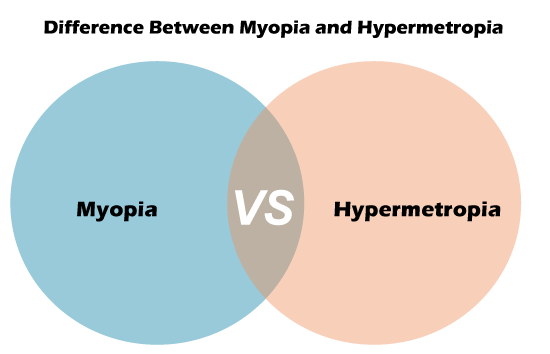Difference between Myopia and HypermetropiaMany of us have studied about the eye in our science classes. The eye is one of the delicate parts of our body. The ailments related to the eye are also delicate. We have always been advised to take care of our eyes for certain reasons. In case of eye ailments, two terms have often been used, i.e., myopia and hypermetropia. These are two kinds of ailments that people go through. These are not proper diseases that are incurable, but these ailments affect the vision of a person. Sometimes, myopia and hypermetropia can be cured by undergoing surgery, but if the situation is much worse, then surgery will not benefit the person. 
But before knowing any further, it is important to know what does myopia and hypermetropia mean and what are the key differences between them. So, without further ado, let us take a look at some fundamental differences between them.
So, these are some key differences between myopia and hypermetropia. The most important difference is that of the image formation. Well, it is interesting to note that myopia and hypermetropia can be divided into three categories, i.e., low, moderate, and high. So, let us begin by classifying myopia.
Now, let us look at the classification of Hypermetropia.
In all the above-mentioned situations, the treatment is different. Every situation in dealt is a certain way by the ophthalmologist. There are two kinds of myopia, i.e., High Myopia and Degenerative Myopia. In High Myopia, the person can suffer from glaucoma, cataract, etc. On the other hand, Degenerative Myopia is a more critical situation, wherein the size o the eyeball increases quickly than other cases of Myopia. Degenerative Myopia is also called as 'Malignant Myopia' and can lead to glaucoma, amblyopia, choroid neovascularization, etc. Now, let us discuss about these complications more deeply.
So, these are some of the medical complications that a person can suffer from in case he/ she has myopia or hypermetropia. The treatment of myopia is done through the concave lens, which is also called as the diverging lens. On the other hand, hypermetropia is treated through the convex lens. People suffering from any condition have to undergo surgery. Myopia and hypermetropia are curable. But people must take care of themselves. To avoid getting any of the above-mentioned complications, one must eat green leafy vegetables and fruits enriched in Vitamin A. This will contribute to one's eye health, and such complications will not occur. Thus, in order to avoid certain complications, taking care of your health is essential.
Next TopicDifference between
|
 For Videos Join Our Youtube Channel: Join Now
For Videos Join Our Youtube Channel: Join Now
Feedback
- Send your Feedback to [email protected]
Help Others, Please Share










